Contents
English
Français
Español
Deutsch
Nederlands
Italiano
Dansk
Svenska
Suomi
Norsk
Čeština
Slovenčina
Polski
Magyar
Safety Notices and Warnings
�
EN
FR
ES
DE
NL
IT
DA
SV
FI
NO
CS
SK
PL
HU
2-5
6-9
10-13
14-17
18-21
22-25
26-29
30-33
34-37
38-41
42-45
46-49
50-53
54-57
58-62
�
Technical Specifications
EN
Mechanical
Power
GPS
Bluetooth
Environmental
Size
Weight
Battery
Battery life
Charge time
Voltage
Charging
Chipset
Frequency
C/A Code
Channels
Tracking sensitivity
Update rate
Cold start
Warm start
Hot start
Reacquisition time
Datum
Protocol
Antenna
Profile
Class
Default PIN
Storage Temperature
Operating Temperature
Humidity
Fluid & Dust Protection
87.8 x 43.0 x 15.1 mm
68g
1200mAh Lithium Ion built-in cell
10hours typical use
Less than 4 hours
4.75V to 6V
From CLA (cigarette lighter adaptor) or AC
Adaptor
SiRF Star III
L1, 1575.42MHz
1.023 MHz Chip Rate
20 channel all-in-view tracking
-159dBm
1Hz
<1 minute typical
<30 seconds typical
<10 seconds typical
<1 second from max 30second blockage
WGS-84
NMEA 0183 Version 2.2
Built-in omnidirectional antenna
Serial Port Profile (SPP)
Class II Version 1.2
0000
-20 to +70 degrees Celsius
-10 to +60 degrees Celsius
Up to 75% non-condensing
IP54
�
�
TomTom GPS receiver
EN
a Power supply
b On/Off button
c GPS indicator
d Charge indicator
Switching on and off
To switch the GPS receiver on or off, press and hold the power button for about 1
second.
GPS Indicator
When switched on, the GPS indicator will be lit green. Once the GPS receiver has
determined your position (“has a fix”), the indicator will flash continuously.
Charge Indicator
If the GPS receiver needs charging, the Charge indicator will be lit red. When the internal
battery is charging the indicator will be lit orange.
�
�
EN
Setting up
Setting up a connection with your PDA or Smartphone
Ensure that the TomTom Wireless GPS receiver is switched on. When you open the
TomTom NAVIGATOR 5 or TomTom MOBILE 5 applications, a connection to the TomTom
Wireless GPS receiver will be made automatically. If you leave your GPS switched on and
do not connect it to your device, it will automatically switch off after 5 minutes in order to
conserve battery life.
Please refer to the Bluetooth connection setup instructions in the documentation that
comes with your PDA, Smartphone or laptop. You will need to set up a Serial Port
connection between the GPS receiver and your device. The GPS receiver will appear to
your device as the “TomTom Wireless GPS” and its GPS signal will be output on its “GPS
serial output”.
To ensure ease of use, create a Bluetooth bond between your device and the GPS
receiver. The pairing code is 0000. Please check specific device setup information on our
support pages at www.tomtom.com.
After setting up the Bluetooth connection, you will need to modify the properties of
the software on your PDA, Smartphone or laptop to use the GPS signal from the GPS
receiver. Please refer to the documentation of your device, and of your software. Choose
the NMEA protocol.
Press and hold the power button for 3 seconds to perform reset.
Mounting
Your TomTom Wireless GPS receiver can be used when in your pocket or bag. When
using it in a vehicle, make sure it is placed correctly for optimal GPS signal reception
and stays in place. You can ensure that the GPS receiver gets a proper GPS signal by
testing it in a stationary situation with your PDA or Smartphone. Note that many modern
vehicles have a heat reflective shield embedded in the windshield preventing good
reception when the GPS receiver is placed on the dashboard. If you have problems
getting a GPS signal, try placing the TomTom Wireless GPS receiver behind a rear
window of your car.
�
�
EN
Charging
For in-vehicle charging, insert the 5V plug
of the cigarette lighter adaptor into the 5V
jack on the rear side of the receiver.
� CLA plug
� GPS receiver plug
AC Charger
Use the AC charger to charge the GPS
receiver at home. You can change the
adaptor of the AC plug to fit your local
power outlet.
A GPS receiver plug
B AC plug
C Adaptor for the USA
D Adaptor for Australia
E Adaptor for the UK
F Adaptor for the rest of Europe
Charging
While charging, the Charge indicator on the side of the receiver will be lit orange.
When charging is completed, the orange indicator switches off.
�
�
Caractéristiques techniques
FR
Caractéristiques
mécaniques
Caractéristiques
électriques
GPS
Bluetooth
Caractéristiques
d’environnement
Taille
Poids
Batterie
Autonomie de la batterie
Temps de chargement
Tension
Chargement
Puce
Fréquence
Code C/A
Canaux
Sensibilité de suivi
Vitesse de mise à jour
Démarrage à froid
Démarrage tiède
Démarrage à chaud
Délai de réacquisition
Données
Protocole
Antenne
Profil
Classe
Code PIN par défaut
Température de stockage
Température d’utilisation
Humidité
Protection contre les liquides et la
poussière
�
87,8 x 43 x 15,1 mm
68 g
Cellule intégrée Ion-Lithium 1 200 mAh
10 heures en conditions normales
Moins de 4 heures
4,75 V à 6 V
Par adaptateur pour allume-cigares ou
adaptateur secteur
SiRF Star III
L1, 1575,42 MHz
Vitesse de processeur 1 023 MHz
Suivi de 20 canaux « tous visibles »
-159 dBm
1Hz
<1 minute typiquement
<30 secondes typiquement
<10 secondes typiquement
<1 seconde à partir d’un blocage maxi. de
30 secondes
WGS-84
NMEA 0183 version 2.2
Antenne omnidirectionnelle intégrée
Profil port série (SSP - Serial Port Profile)
Classe II version 1.2
0000
-20 à +70°C
-10 à +60°C
Jusqu’à 75 % sans condensation
IP54
�
TomTom GPS receiver
FR
a
b Bouton marche/
c Témoin de réception
d Témoin de charge
Mise sous tension et hors tension
Pour mettre le récepteur GPS sous tension, appuyez sur le bouton marche-arrêt et
maintenez-le enfoncé pendant environ 1 seconde.
Pour mettre le récepteur hors tension, appuyez sur le bouton marche-arrêt pendant
1 seconde.
Témoin d’allumage et de réception GPS
Lorsque le récepteur est allumé, le témoin GPS s’allume en vert. Une fois que le
récepteur GPS a déterminé votre position (« acquis un signal »), le témoin clignote
continuellement.
Témoin de charge
Si le récepteur GPS a besoin d’être chargé, le témoin de charge reste allumé en rouge.
Lorsque la batterie interne est en cours de chargement, ce témoin passe à l’orange.
�
�
FR
Configuration
Configuration d’une connexion avec votre PDA ou votre téléphone portable
Vérifiez que le récepteur TomTom Wireless GPS est sous tension. Lorsque vous ouvrez
l’application TomTom NAVIGATOR 5 ou TomTom MOBILE 5, la connexion au récepteur
TomTom Wireless GPS s’établit automatiquement. Si vous laissez votre GPS allumé et
ne le connectez pas à votre périphérique, il s’éteindra automatiquement au bout de 5
minutes, pour préserver la durée de la batterie.
Veuillez vous reporter aux instructions de configuration d’une connexion Bluetooth dans
la documentation qui accompagne votre organiseur personnel, votre téléphone portable
ou votre ordinateur portable. Vous devez configurer une connexion de port série entre
le récepteur GPS et votre périphérique. Votre périphérique perçoit le récepteur GPS en
tant que « GPS sans fil TomTom », et son signal GPS est transmis à sa sortie série GPS.
Pour faciliter l’utilisation, établissez une liaison Bluetooth entre le périphérique et le
récepteur GPS. Le code de couplage est 0000. Vérifiez les informations de configuration
du périphérique, aux pages de support technique du site www.tomtom.com.
Après avoir configuré la connexion Bluetooth, vous devez modifier les propriétés du
logiciel sur votre organiseur personnel, votre téléphone intelligent ou votre ordinateur
portable, pour utiliser le signal GPS du récepteur. Pour plus d’informations, reportez-vous
à la documen-tation de votre périphérique et de votre logiciel. Choisissez le protocole
NMEA.
Appuyez sur le bouton marche-arrêt et maintenez-le enfoncé pendant environ 3 seconde
pour réinitialiser.
Montage
Votre récepteur TomTom Wireless GPS continue de fonctionner lorsqu’il se trouve dans
votre poche ou dans votre sac. Lorsque vous l’utilisez à bord d’un véhicule, placez-le de
manière à assurer la meilleure réception GPS possible, et laissez-le au même endroit
pendant tout le trajet. Pour vérifier que votre GPS reçoit un signal adéquat, testez-le avec
votre PDA ou votre téléphone portable en position stationnaire. Notez que de nombreux
véhicules modernes sont équipés d’un pare-brise à réfléchissement thermique qui ne
permet pas une réception correcte lorsque le récepteur GPS est placé sur le tableau de
bord. Si vous ne parvenez pas à obtenir un signal GPS, essayez de placer le récepteur
TomTom Wireless GPS sur la plage arrière du véhicule.
�
�
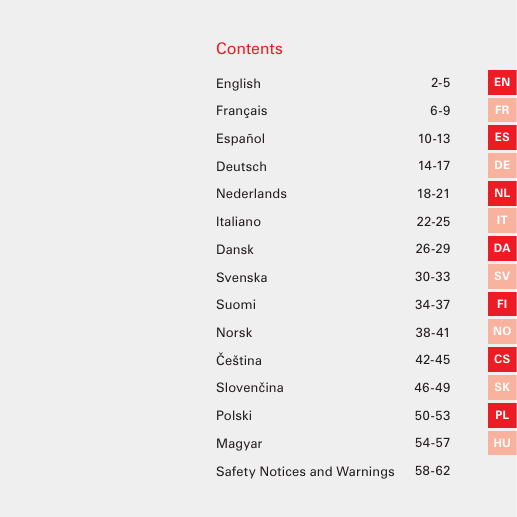
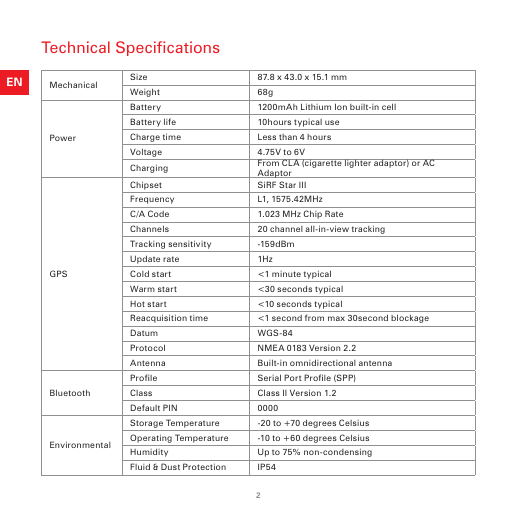
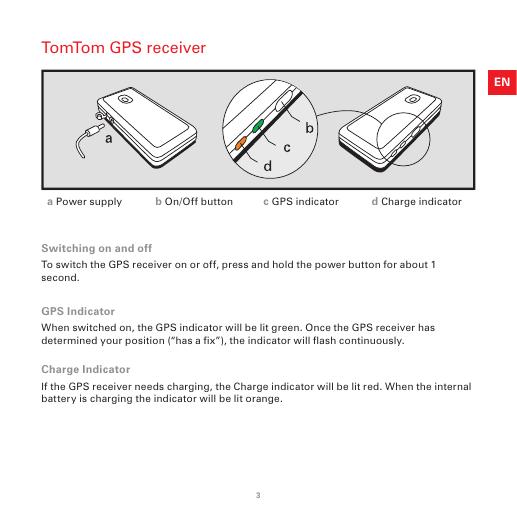
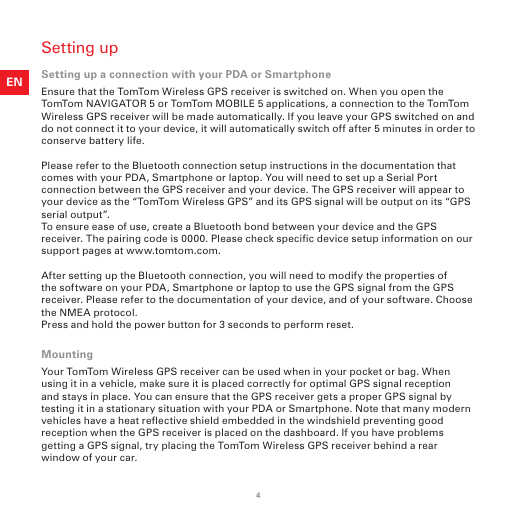

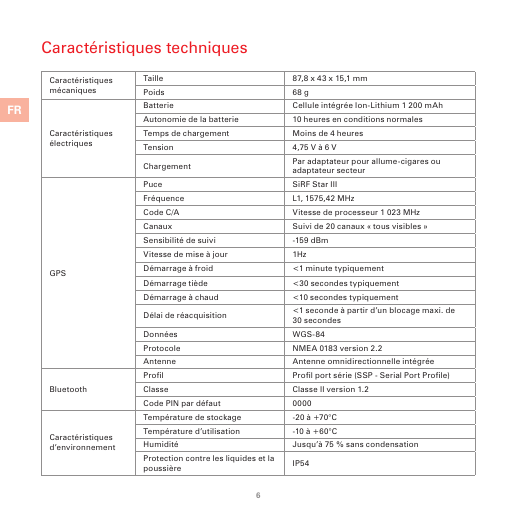
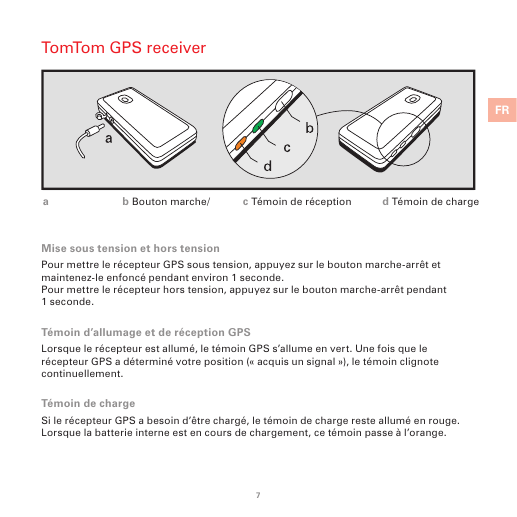
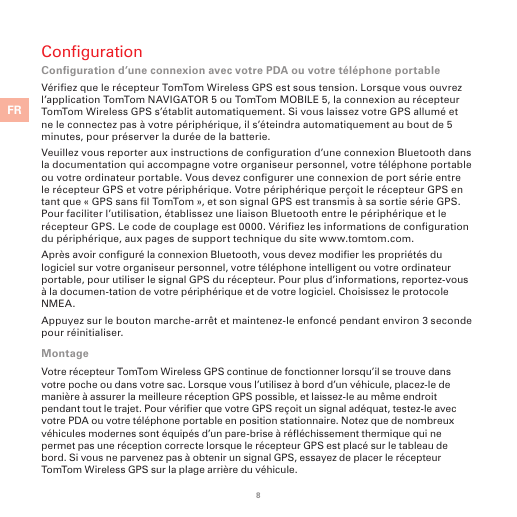








 2023年江西萍乡中考道德与法治真题及答案.doc
2023年江西萍乡中考道德与法治真题及答案.doc 2012年重庆南川中考生物真题及答案.doc
2012年重庆南川中考生物真题及答案.doc 2013年江西师范大学地理学综合及文艺理论基础考研真题.doc
2013年江西师范大学地理学综合及文艺理论基础考研真题.doc 2020年四川甘孜小升初语文真题及答案I卷.doc
2020年四川甘孜小升初语文真题及答案I卷.doc 2020年注册岩土工程师专业基础考试真题及答案.doc
2020年注册岩土工程师专业基础考试真题及答案.doc 2023-2024学年福建省厦门市九年级上学期数学月考试题及答案.doc
2023-2024学年福建省厦门市九年级上学期数学月考试题及答案.doc 2021-2022学年辽宁省沈阳市大东区九年级上学期语文期末试题及答案.doc
2021-2022学年辽宁省沈阳市大东区九年级上学期语文期末试题及答案.doc 2022-2023学年北京东城区初三第一学期物理期末试卷及答案.doc
2022-2023学年北京东城区初三第一学期物理期末试卷及答案.doc 2018上半年江西教师资格初中地理学科知识与教学能力真题及答案.doc
2018上半年江西教师资格初中地理学科知识与教学能力真题及答案.doc 2012年河北国家公务员申论考试真题及答案-省级.doc
2012年河北国家公务员申论考试真题及答案-省级.doc 2020-2021学年江苏省扬州市江都区邵樊片九年级上学期数学第一次质量检测试题及答案.doc
2020-2021学年江苏省扬州市江都区邵樊片九年级上学期数学第一次质量检测试题及答案.doc 2022下半年黑龙江教师资格证中学综合素质真题及答案.doc
2022下半年黑龙江教师资格证中学综合素质真题及答案.doc